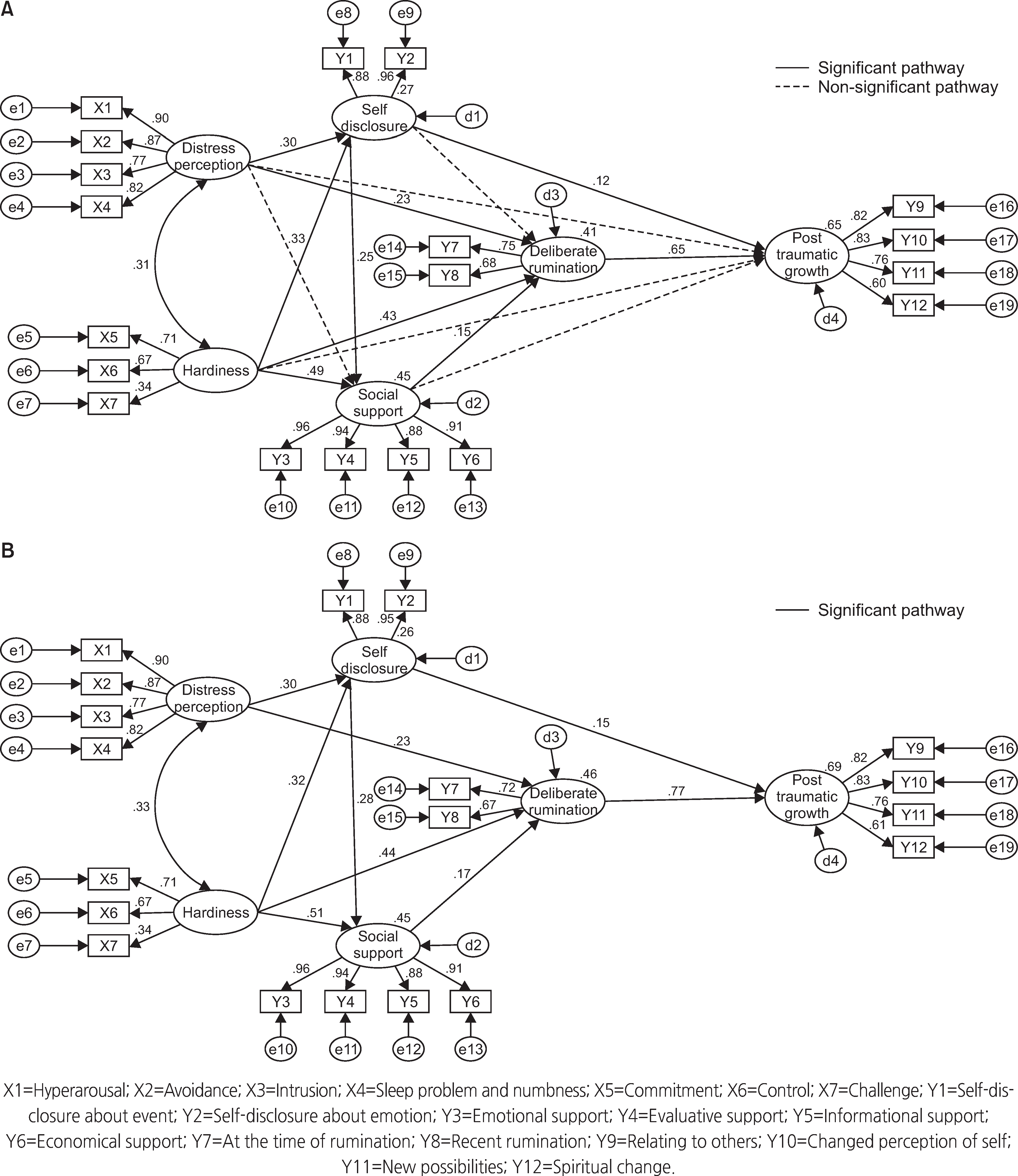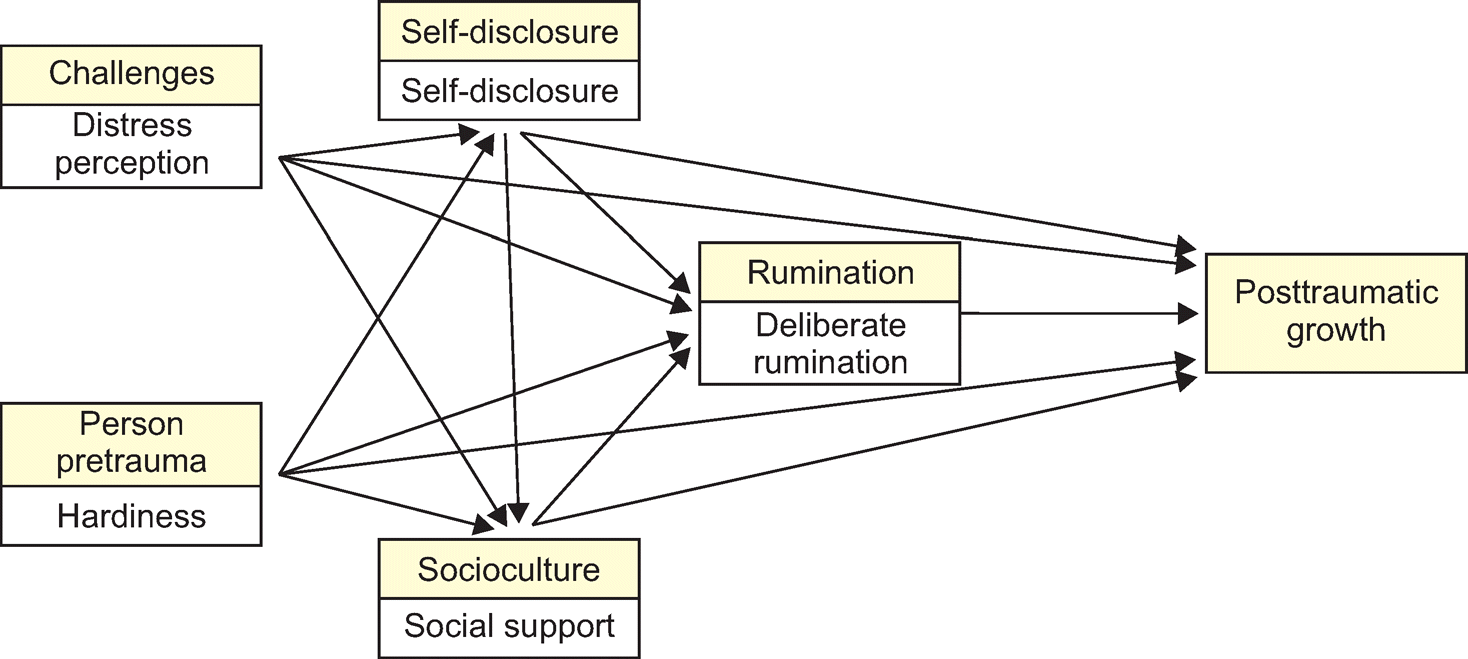Abstract
Purpose:
The purpose of this study was to explain a structural model of posttraumatic growth among psychiatric nurses based on existing models and a literature review and verify its effectiveness.
Methods:
Data were collected from psychiatric nurses in one special city, four metropolitan cities, and three regional cities from February to March 2016. Exogenous variables included hardiness and distress perception, while endogenous variables included self-disclosure, social support, deliberate rumination, and posttraumatic growth. Data from 489 psychiatric nurses were analyzed using IBM SPSS Statistics 19.0 and AMOS 20.0.
Results:
The modified model was a good fit for the data. Tests on significance of the pathways of the modified model showed that nine of the 14 paths were supported, and the explanatory power of posttraumatic growth by included variables in the model was 69.2%. For posttraumatic growth among psychiatric nurses, deliberate rumination had a direct effect as the variable that had the largest influence. Indirect effects were found in the order of hardiness, social support, and distress perception. Self-disclosure showed both direct and indirect effects.
Conclusion
A strategy to improve deliberate rumination is necessary when seeking to improve posttraumatic growth among psychiatric nurses. Enhancing psychiatric nurses’ hardiness before trauma would enable them to actively express negative emotions after trauma, allowing them to receive more social support. This would improve deliberate rumination and consequently help promote psychological growth among psychiatric nurses who have experienced trauma.
REFERENCES
1. Pines, AM. Treating career burnout: A psychodynamic existential perspective. Journal of Clinical Psychology. 2000; 56(5):633–642.
2. Yang S, Lee GJ, Yu SJ. A comparative study on work satisfaction of PMHNPs in the hospital and community. Journal of Korean Academy of Psychiatric and Mental Health Nursing. 2004; 13(4):487–495.
3. Nijman H, Bowers L, Oud N, Jansen G. Psychiatric nurses’ experiences with inpatient aggression. Aggressive Behavior. 2005; 31(3):217–227. https://doi.org/10.1002/ab.20038.

4. Moylan LB, Cullinan M. Frequency of assault and severity of injury of psychiatric nurses in relation to the nurses’ decision to restrain. Journal of Psychiatric and Mental Health Nursing. 2011; 18(6):526–534. https://doi.org/10.1111/j.1365-2850.2011.01699.x.

5. Takahashi C, Chida F, Nakamura H, Akasaka H, Yagi J, Koeda A, et al. The impact of inpatient suicide on psychiatric nurses and their need for support. BMC Psychiatry. 2011; 11:38. https://doi.org/10.1186/1471-244X-11-38.

6. Figley CR. Compassion fatigue: Coping with secondary traumatic stress disorder in those who treat the traumatized. New York: Brunner-Routledge;1995. p. 17–107.
7. Lee J, Daffern M, Ogloff JRP, Martin T. Towards a model for understanding the development of post‐traumatic stress and general distress in mental health nurses. International Journal of Mental Health Nursing. 2015; 24(1):49–58. https://doi.org/10.1111/inm.12097.

8. Song MJ, Park WJ. Effects of violence experience and human rights on burnout of psychiatric nurses in national mental hospitals. Korean Journal of Scientific Criminal Investigation. 2015; 9(2):97–106.
9. Choi SM. Exploration of posttraumatic growth related variables [dissertation]. Seoul: Korea University;2008. p. 1–107.
10. Bae JI. A experience of the psychiatric nurse: A phenomenological approach. Journal of Korean Academy of Psychiatric and Mental Health Nursing. 1998; 7(2):298–309.
11. Calhoun LG, Tedeschi RG. The foundations of posttraumatic growth: An expanded framework. Calhoun LG, Tedeschi RG, editors. Handbook of Posttraumatic Growth: Research and Practice. Mahwah (NJ): Lawrence Erlbaum Associates;2006. p. 3–23.
12. Linley PA, Joseph S. Positive change following trauma and adversity: A review. Journal of Traumatic Stress. 2004; 17(1):11–21. https://doi.org/10.1023/B:JOTS.0000014671.27856.7e.

13. Vishnevsky T, Cann A, Calhoun LG, Tedeschi RG, De-makis GJ. Gender differences in self-reported posttraumatic growth: A meta-analysis. Psychology of Women Quarterly. 2010; 34(1):110–120. https://doi.org/10.1111/j.1471-6402.2009.01546.x.

14. Shakespeare-Finch J, Gow K, Smith S. Personality, coping and posttraumatic growth in emergency ambulance personnel. Traumatology. 2005; 11(4):325–334. https://doi.org/10.1177/153476560501100410.

15. Song H, Lee YS. The effects of hardiness and emotional intelligence of posttraumatic growth: Active coping as mediating variable. Korean Journal of Counseling. 2011; 12(4):1231–1246. https://doi.org/10.15703/kjc.12.4.201108.1231.
16. Yu HJ. The mediating effects of social support and deliberate rumination in the influence of distress by trauma on posttraumatic growth. Journal of the Korean Data & Information Science Society. 2018; 29(4):997–1012. https://doi.org/10.7465/jkdi.2018.29.4.997.

17. Joseph S, Linley PA. Positive psychological perspectives on posttraumatic stress: An integrative psychosocial framework. Joseph S, Linley PA, editors. Trauma, Recovery, and Growth: Positive Psychological Perspectives on Posttraumatic Stress. Hoboken (NJ): John Wiley & Sons;2008. p. 3–20.

18. Jung M. The effects of university students’ self-disclosure, social support, and intentional rumination on posttraumatic growth: Verification of gender difference. The Journal of Han-young Theological University. 2014; 18:169–184.
19. Nishi D, Matsuoka Y, Kim Y. Posttraumatic growth, posttraumatic stress disorder and resilience of motor vehicle accident survivors. BioPsychoSocial Medicine. 2010; 4:7. https://doi.org/10.1186/1751-0759-4-7.

20. Schroevers MJ, Helgeson VS, Sanderman R, Ranchor AV. Type of social support matters for prediction of posttraumatic growth among cancer survivors. Psycho-Oncology. 2010; 19(1):46–53. https://doi.org/10.1002/pon.1501.

21. Lindstrom CM, Cann A, Calhoun LG, Tedeschi RG. The relationship of core belief challenge, rumination, disclosure, and sociocultural elements to posttraumatic growth. Psychological Trauma: Theory, Research, Practice, and Policy. 2013; 5(1):50–55. https://doi.org/10.1037/a0022030.

22. Itzhaki M, Peles-Bortz A, Kostistky H, Barnoy D, Filshtinsky V, Bluvstein I. Exposure of mental health nurses to violence associated with job stress, life satisfaction, staff resilience, and post-traumatic growth. International Journal of Mental Health Nursing. 2015; 24(5):403–412. https://doi.org/10.1111/inm.12151.

23. Shin HJ, Kim KH. Emotional labor and professional quality of life in Korean psychiatric nurses. Health and Social Welfare Review. 2015; 35(4):190–216.
24. Calhoun LG, Tedeschi RG. Posttraumatic growth in clinical practice. 1st Engl. Ed.Kang YS, Yim JR, Jang A, Roh AY, translators. Seoul: Hakjisa;2015. p. 44–189.
25. Kloss JD, Lisman SA. An exposure‐based examination of the effects of written emotional disclosure. British Journal of Health Psychology. 2002; 7(1):31–46. https://doi.org/10.1348/135910702169349.

26. Shin SY. The effect of meaning in life and social support on posttraumtic growth: Rumination as a mediating variable. [master’s thesis]. Bucheon: The Catholic University of Korea;2009. p. 1–59.
27. Frattaroli J. Experimental disclosure and its moderators: A meta-analysis. Psychological Bulletin. 2006; 132(6):823–865. https://doi.org/10.1037/0033-2909.132.6.823.

28. Mitchell RJ. Path analysis: Pollination. Scheiner SM, Gure-vitch J, editors. Design and Analysis of Ecological Experiments. New York: Chapman and Hall;1993. p. 211–231.
29. Tedeschi RG, Calhoun LG. The posttraumatic growth inventory: Measuring the positive legacy of trauma. Journal of Traumatic Stress. 1996; 9(3):455–471. https://doi.org/10.1002/jts.2490090305.

30. Song SH, Lee HS, Park JH, Kim KH. Validity and reliability of the Korean version of the posttraumatic growth inventory. Korean Journal of Health Psychology. 2009; 14(1):193–214.
31. Horowitz M, Wilner N, Alvarez W. Impact of event scale: A measure of subjective stress. Psychosomatic Medicine. 1979; 41(3):209–218. http://doi.org/10.1097/00006842-197905000-00004.

32. Weiss DS, Marmar CR. The impact of event scale-revised. Keane TM, Wilson JP, editors. Assessing Psychological Trauma and PTSD. New York: Guilford Press;1997. p. 399–411.
33. Eun HJ, Kwon TW, Lee SM, Kim TH, Choi MR, Cho SJ. A study on reliability and validity of the Korean version of impact of event scale-revised. Journal of the Korean Neuropsychiatric Association. 2005; 44(3):303–310.
34. Bartone PT. A short hardiness scale. Paper presented at: the Annual Convention of the American Psychological Society. 1995. Jun 29-Jul 2; New York, NY.

35. Cho JY, Lee YW, Kim HS, Kim SH. Relationships among response for violence experience, hardiness, and job satisfaction of nurses working in emergency department. Korean Journal of Adult Nursing. 2011; 23(5):494–502.
36. Park JH. Effects of rumination, thought suppression, and self-disclosure about the stressful life event on emotion and subjective well-being [dissertation]. Seoul: Sungkyunkwan University;2007. p. 1–239.
37. Park JW. A study to development a scale of social support [dissertation]. Seoul: Yonsei University;1985. p. 1–127.
38. Calhoun LG, Cann A, Tedeschi RG, McMillan J. A correlational test of the relationship between posttraumatic growth, religion, and cognitive processing. Journal of Traumatic Stress. 2000; 13(3):521–527. http://doi.org/10.1023/A:1007745627077.

39. Kim GS. (Amos 18.0) Analysis structural equation modeling. Seoul: Hannarae Publishing;2010. p. 1–663.
40. Moon SB. Basic concepts and applications of structural equation modeling with AMOS17.0. Seoul: Hakjisa;2009. p. 1–680.
41. Taku K, Cann A, Tedeschi RG, Calhoun LG. Intrusive versus deliberate rumination in posttraumatic growth across US and Japanese samples. Anxiety, Stress and Coping. 2009; 22(2):129–136. https://doi.org/10.1080/10615800802317841.

42. Silvia PJ, Phillips AG. Evaluating self-reflection and insight as self-conscious traits. Personality and Individual Differences. 2011; 50(2):234–237. https://doi.org/10.1016/j.paid.2010.09.035.

43. Weiss T. Correlates of posttraumatic growth in married breast cancer survivors. Journal of Social and Clinical Psychology. 2004; 23(5):733–746. https://doi.org/10.1521/jscp.23.5.733.50750.

44. Florian V, Mikulincer M, Taubman O. Does hardiness contribute to mental health during a stressful real-life situation? The roles of appraisal and coping. Journal of Personality and Social Psychology. 1995; 68(4):687–695. https://doi.org/10.1037/0022-3514.68.4.687.

45. Paivio SC, Laurent C. Empathy and emotion regulation: Reprocessing memories of childhood abuse. Journal of Clinical Psychology. 2001; 57(2):213–226. https://doi.org/10.1002/1097-4679(200102)57:2<213::aid-jclp7>3.0.co;2-b.

46. Tedeschi RG, Calhoun LG. Target article: “Posttraumatic growth: Conceptual foundations and empirical evidence”. Psychological Inquiry. 2004; 15(1):1–18. https://doi.org/10.1207/s15327965pli1501_01.

Figure 2.
Hypothetical and modified structural model with parameter estimates. (A) Hypothetical structural model with parameter estimates. (B) Modified structural model with parameter estimates.

Table 1.
General Characteristics of the Subjects (N=489)
Table 2.
Correlations among Measured Variables (N=489)
X1=Hyperarousal; X2=Avoidance; X3=Intrusion; X4=Sleep problem and numbness; X5=Commitment; X6=Control; X7=Challenge; Y1=Self-disclosure about event; Y2=Self-disclosure about emotion; Y3=Emotional support; Y4=Evaluative support; Y5=Informational support; Y6=Economical support; Y7=At the time of rumination; Y8=Recent rumination; Y9=Relating to others; Y10=Changed perception of self; Y11=New possibilities; Y12=Spiritual change. AVE=Average variance extracted; CCR=Composite construct reliability; M=Mean; SD=Standard deviation.
Table 3.
Parameter Estimates for Modified Structural Model and Standardized Direct, Indirect, and Total Effects




 PDF
PDF ePub
ePub Citation
Citation Print
Print



 XML Download
XML Download